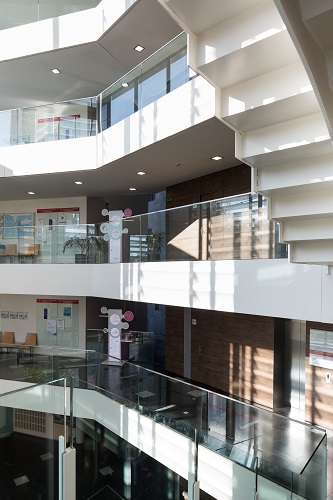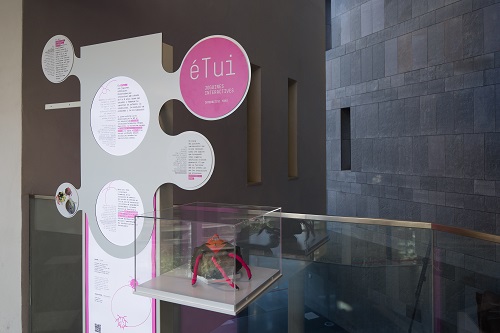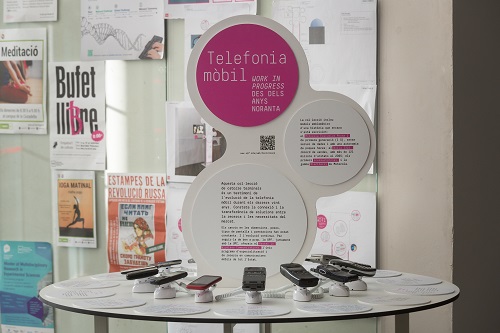Techno Track, a showcase to demonstrate the impact of research in the field of ICT
Techno Track, a showcase to demonstrate the impact of research in the field of ICT
The circuit, spread over different floors of the Tànger building of the Poblenou campus, initially consists of five projects from the last fifteen years, developed by the research groups at UPF’s Department of Information and Communication Technologies.

The research of the last fifteen years conducted at the UPF’s Department of Information and Communication Technologies (DTIC) now has a showcase, initially consisting of five different thematic projects, which will enable disclosing its social and economic impact.
We are, of course, referring to the Techno Track, a permanent display of artefacts and projects developed by the research groups of the DTIC, housed in the Tànger building on the Poblenou campus. Aimed at the general public and students, it will be updated and expanded over time, until it totals some fifteen projects.
Visiting hours to the technology circuit, distributed in different corners of floors -1, the ground floor and the first and second floors of Tànger, adapt to the opening hours of the building. So, this Christmas it will remain closed, but as of 8 January 2018, it will be open from Monday to Friday from 8 am to 10 pm.
“We want society, and especially future students, to see that the courses we offer involve research and teaching, and that such an offer in the world of engineering is unique”, says Miquel Oliver, director of the DTIC and promoter of Techno Track, who plans to hold an inauguration ceremony in the coming months.
“Our intention is to improve communication at our Department, link teaching and research promoting the latter, and thus attract better students”, says Miquel Oliver. On the selected projects, he explains that “this is an internal choice, a taste of projects with an impact on society that are representative of the different disciplines the research groups work with”.
According to the director of the DTIC, this initiative, that takes advantage of the momentum of the UPF Art Track on the Ciutadella campus, benefits from the surroundings of the Tànger building, “a friendly building with visibility, that we aim to turn into a showcase for the results of our research, following the model of the universities of the United States, such as Massachusetts Institute of Technology”.
Music and interactive technology, mobile communications and neural interfaces

The five research projects and artefacts on display were initially opened to the public on 15 December 2017, coinciding with the investiture as doctor honoris causa of Dorcas Muthoni, who personally visited the different areas of the Techno Track.
As mentioned on one of the panels, these are projects that have international repercussions, some with European funding, and very often are carried out in collaboration with institutions and companies of other countries. The circuit is structured by means of a series of totems, some of which are accompanied by monitors projecting explanatory videos.
One initial project is “éTui, interactive toys”, robotic toys designed to interact with children from 4 to 8 years of age; tools to study and promote the capacity for reflection, creativity, problem solving and collaboration. It was developed by Josep Blat, Claudia Torres and Dai Griffiths, researchers of the Interactive Technologies group (GTI), between 1998 and 2001.
“Injectable implants to restore nerve communications”, consists of the development of microstimulators that will be implanted with such a simple procedure as an injection. They will form a wireless network of smart devices, with the aim of causing neuromuscular stimulation, which allows recovering motor functions in patients who suffer from paralysis. It will be carried out during the next five years by Antoni Ivorra and Laura Becerra-Fajardo of the Biomedical Electronics Research Group (BERG).

“Mobile telephony. Work in progress since the 1990s”, is a collection of fourteen terminals, which establishes the connection and transfer of solutions between research and market needs. It includes emblematic models of a history that is still being written, such as the first generation (1G) Motorola Executive Phone 2 or the Nokia 3310, which enjoyed record sales, with more than 121 million units sold in 2005.
“Reactable, the musical instrument of the 21st century” focuses on this new electronic musical instrument, the Reactable which is played by moving objects on a surface towards and away from each other. Sergi Jordà, Günter Geiger, Martin Kaltenbrunner and Marcos Alonso, of the Music Technology Group (MTG), developed it between 2003 and 2008.
Finally, “Barcelona WiFi, the most extensive WiFi network on the planet”, talks about the most extensive public network for access to Internet in the world, both insofar as its volume and the number of users, and the one with the most years of uninterrupted service. Its origin dates back to research agreements of 2004-2006 between UPF, Barcelona City Council and the 22@ district with Miquel Oliver and Jorge Infante, of the NeTS Research Group, as researchers.

